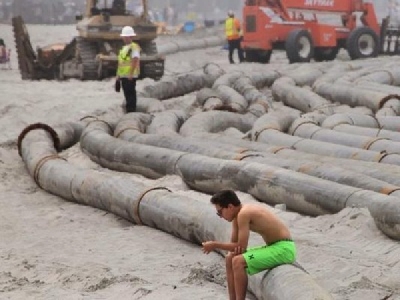
Posted on August 14, 2018
Oceanside’s City Council asked staffers this week for a study of ways the city can lead its own project to get more sand out of its clogged harbor and onto its eroded beaches.
The city is growing increasingly concerned over the U.S. Army Corps of Engineers’ failure to dredge the harbor this year, along with the federal agency’s inability to complete other projects that could beef up Oceanside’s beaches.
A recent survey showed the harbor entrance channel is now only 16 feet deep at points, Dena O’Dell, Army Corps deputy chief of public affairs, said in an email Thursday. A month ago, the channel was reported to be 20 feet deep and, when freshly dredged, it can be 26 feet deep or greater.
Compounding navigation difficulties is a sand shoal, an underwater sandbar, that builds on the tip of the rock jetty at the harbor entrance and increases the size of waves.
“The south side shoal, extending from the top of the south jetty, is from 8 and 10 feet deep,” O’Dell said.
Army Corp officials are working closely with the city to determine when the next dredging will occur, she said.
City officials have been unhappy for some time with the way the federal agency has handled Oceanside projects.
“Sand on the beach is a significant tourism driver, an economic driver,” said Mayor Peter Weiss, who asked the council to take on the issue at a meeting Wednesday.
Ocean currents, tides and waves constantly push sand into the harbor entrance, and without the annual spring dredging, the harbor would eventually fill up. Also, sand from the harbor entrance is piped onto nearby beaches to keep them wide and attractive for Oceanside residents and visitors.
However, this year for the first time in a decade or longer, there was no dredging.
The Corps of Engineers was unable to get a permit needed from the Regional Water Quality Control Board to do the dredging as planned in April.
Since then, the harbor entrance has grown steadily more shallow. Some captains already have cancelled trips on days with large surf, which means lost business for the marina.
Public safety is the city’s top priority, said Councilman Chuck Lowery. As the harbor entrance grows more shallow, the chances increase that a large wave could flip a boat.
“The situation is worse now than it has been in the past,” Lowery said.
“We have waited long enough,” said Councilman Jack Feller. “In the last couple years, we’ve had a tough dance with the Army Corps.”
Dredging the Oceanside harbor has been the city’s most consistent source of beach sand since the 1960s. But sand can come from other sources.
Oceanside has been waiting 20 years for the Corps of Engineers to excavate the San Luis Rey River, a flood-control project that would protect homes along the river and produce as much as 230,000 cubic yards of sand to spread along the coast. That work was scheduled to start in 2016 and 2017, but fell through both years when the Corps failed to get the permits required from state and regional agencies.
“I’m tremendously frustrated with the Army Corps of ‘Bureaucrats,’” Councilman Jerry Kern said Monday. “They have become increasingly unreliable. We need to take the lead and try and do it ourselves.”
Councilwoman Esther Sanchez said she supports the city’s study, but she has concerns that by itself the city may be unable to afford the project, which is likely to cost millions of dollars.
The Corps of Engineers is responsible for keeping the harbor, built in the 1960s, open and safe, and the agency pays most of the costs for that, about $5 million annually.
Last year, Oceanside and the U.S. Navy paid a portion of the costs to get extra sand on the beach.
Some people have said that the extra sand dredged last year lessened the need for the job this year. Others have said the increased work in 2017 only took sand levels back to normal because of dredging problems that reduced the amount of material moved in 2016.
The Corps of Engineers and the city Police Department’s Harbor Patrol monitor sand levels to assure that the harbor entrance is safe.
Other funding sources also may be available for the sand project, city officials said. One possibility is a half-cent sales tax the city’s voters will see on their November ballot.
The San Diego Association of Governments also has helped with sand projects.
SANDAG administered a $23 million program in 2012 that pumped a total of 1.5 million cubic yards of sand from nearby ocean deposits onto eight different county beaches, including Oceanside. The California Department of Boating and Waterways paid a large share of the costs, with help from the cities involved.
Those offshore deposits could be tapped again, Oceanside officials have said.
Another possibility Oceanside wants to look at is the sand bypass system that the Corps of Engineers operated in the harbor from 1989 to 1993, when the federal funding for that effort was discontinued. The year-round system vacuumed sand from the entrance and piped it onto nearby beaches.
In the meantime, council members said, they continue to push for the Corps of Engineers to complete the dredging work it had planned for this year.
Source: The San Diego Union-Tribune





